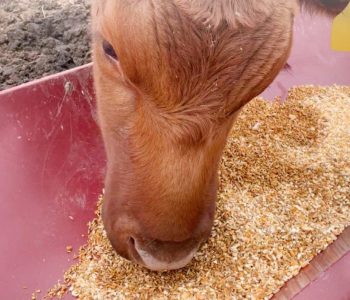This second installment on beef calf nutrition and weaning practices, focuses on rumen development.
Offering feed to calves at an early age, contributes to stimulating rumen development from an earlier stage.
Soon after birth, the rumen is still small and underdeveloped. Up until the four weeks of age while the calf is still suckling and with limited access to forage, the rumen remains greatly underdeveloped. During this stage, in which the calf is mainly receiving milk or milk substitute, the abomasum is the most developed organ within the animal’s digestive system.
Subsequently, at six weeks of age, the difference in rumen size for calves fed different diets is even more significant (Figure 2). The calf who received grains, in addition to milk as part of its diet, already has a significantly more developed rumen than other calves which did not receive this diet at six weeks of age.
In addition to the growth in size, the functional development of the rumen is another benefit associated with this type of supplementation. Internally there is a great difference in the formation of rumen papillae, leading to a greater rumen wall and surface for the absorption of nutrients. Figure 3 allows to compare rumen wall development for three different diets. Which are as follows:
- milk,
- milk and grains
- milk and hay
Besides a greater development of papillae, a more vascularized and thick wall was also observed when compared to other rumens. The rumen wall was thinner and its papillae practically had no development in those animals that were given the dietary treatments without grains.
It can be seen that those animals which were supplied with grains in their diets, presented an earlier stimulation of their ruminal development compared to those that did not receive grains. In other words, their rumen will be functional sooner, having a greater ability to digest and absorb nutrients. Resulting in faster growth for these animals.
CREEP FEEDING
As previously mentioned, another nutritional strategy that can contribute to a quicker development of the calf’s digestive tract, is the implementation of creep feeding systems. In addition to the aforementioned benefits, this type of nutritional strategy aims to accustom the calf to eating in feeders from an early age.
ANother advantage of this type of system, is the improved weaning weight of calves at around six to eight months, which prevents a prolonged period of intensive lactation for the cow.
This method consists of feeding the calf at the foot of the cow. Providing a fenced space with exclusive access to the calf, where the feed is supplied (Figures 4 and 5).
There is an alternative to this type of management practice, that consists of complementing part of the feed with differentiated pastures/forages. These are composed by forages with high nutritional values.
This system has the same goal as the previous one and it is known as creep grazing.
It represents an alternative, in which the weight gain of the calf tend to be a little lower, but it contributes to reduce the dependence on breast milk which is a main objective.
Practical test
A recent study was carried out on a beef cattle farm in Brazil to prove the efficiency creep feeding systems.
The trials were carried out during the second half of summer and the autumn months. A period in which there is a shortage of fodder. In total there were 120 days of supervision and testing.
The results for daily weight gain and the input and output weights for the dietary treatments are shown in Table 1. Besides reducing calves’ dependance on breast milk during this period, a rapid response to supplementation was also observed.
These results can be positively assessed through several aspects.
You may also be interested in: “Calf nutrition: weaning practices – Part I.”
